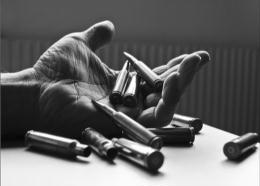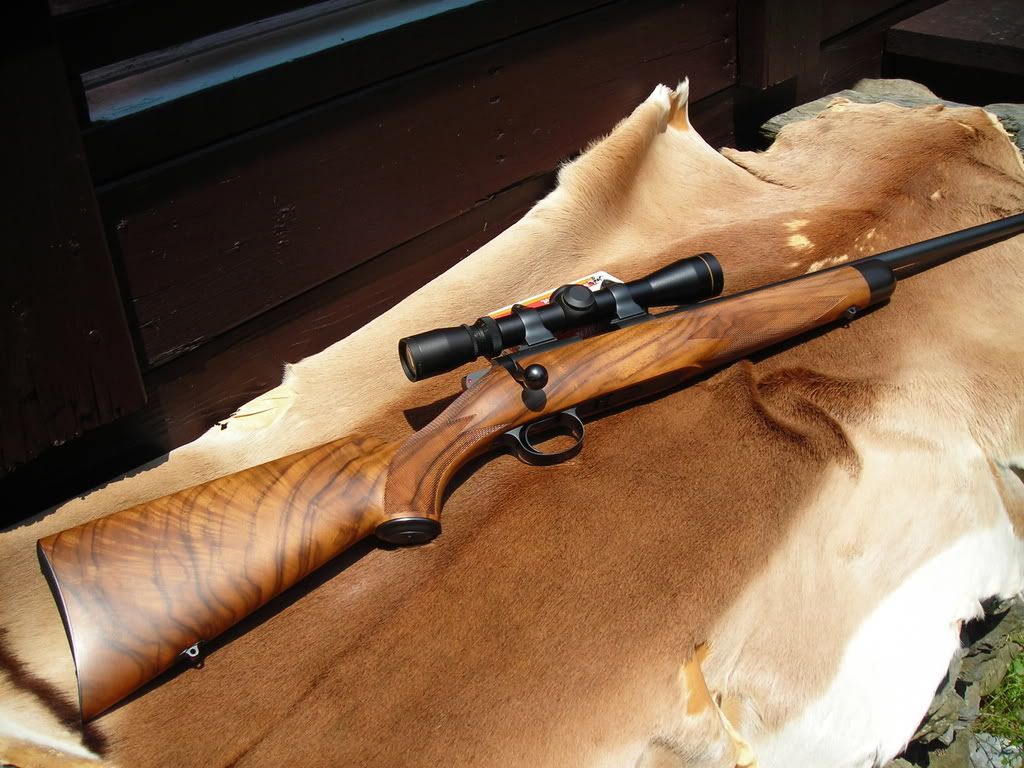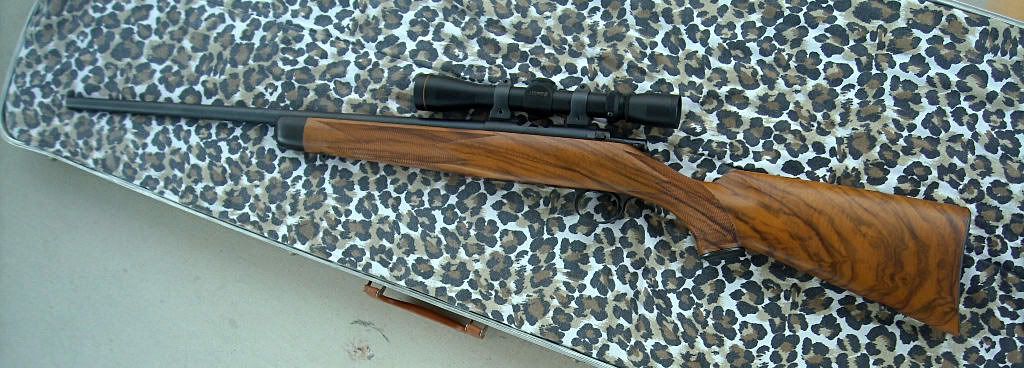Stoney -
I don't know if this info is correct, but I found it on-line. I also don't know if it will help any, but it might, so here it is:
-------------------------------------------
"Kimber 82
Notes: This is a primarily rimfire weapon, some versions of which also chamber centerfire cartridges. There are three broad categories of the Model 82: the Model 82, Model 82A and Model 82B. “A” models used a bolt mechanism which was improved over previous designs, and were built in left and right-handed versions. “B” patterns also improved the lock time by improving the striker mechanism and had a swept-back bolt handle. A-pattern rifles were built from 1986-88, and B-patterns were made from 1988-91. The basic rifle (Model 82 Classic) chambered two rimfire and two centerfire cartridges, used a walnut stock with a half-length fore-end, a pistol grip wrist with a polished steel cap, and a checkered steel buttplate. The safety is a radial switch behind the bolt handle. The barrel is 22 inches. Normal magazines held four rounds, though a 10-round magazine could be ordered from the company.
There were many variants, most of which are identical to the standard Kimber 82 Classic for game purposes. The Classic Custom used a better grade of walnut than the Classic, and also chambered .218 Bee and .25-20 Winchester in single-shot versions (but these two were made only in 1985). The Model 82 Super America was built from 1983-88, and then again from 1990-91. It has a very fine-quality walnut stock, a checkered steel Niedner buttplate, and detachable scope bases. The Model 82 Cascade was built from 1983-85; it had a Monte Carlo comb and cheekpiece, but enjoyed only a short life since the Kimber 84 came out at about the same time. The Custom Match was built only during 1984; it had a French walnut stock, a rust-blue finish, fine checkering, and very close tolerances for its parts. 1986’s Brownell Commemorative is a very fancy version made to mark the death of Leonard Brownell, the optics inventor. It used a full-length fore-end. The Centennial was built in 1987 to celebrate the 100th year since the introduction of the .22 Long Rifle cartridge, and had a select walnut stock, engraved action, and a match-grade barrel. The Continental was built in small numbers from 1987-91, with a Mannlicher-style stock. The Government Model is a heavy-barreled version designed for use by the US Army for training participants in its match team. It has an extra-deep fore-end and a butt with adjustable spacers. Though designed specifically for the Army, a virtually identical model was sold to civilians from 1990-91. The Super Continental of 1987-88 was basically a super-deluxe version of the Continental. The Mini Classic was basically a version of the Classic with 18-inch barrel and sling swivels, and chambered only in .22 Long Rifle. It was built only in 1988. The Deluxe Grade replaced the Classic and Classic Custom in 1989 (until 1990, anyway, in the case the Classic). It chambered only .22 Long Rifle, and had a AA-grade walnut stock. The Decennial was built only in 1989 to celebrate Kimber’s first ten years, and had special markings to show this. The Super Grade also appeared in 1989, briefly replacing the Super America; it was never popular. The All-American Match was a single-shot rifle similar to the Government Model in form, but with a 25-inch heavy match barrel, adjustable trigger, and a buttplate adjustable for height as well as having spacers for adjusting the length. It was built from 1990-91. The Hunter is basically a Super America with a matte blue finish for its metalwork. The Varminter, built from 1990-91, was chambered only in .22 Long Rifle, and used a 25-inch barrel and a rubber shoulder pad. The last Model 82 (of the older patterns) was 1991’s Sporter. Built shortly before Kimber’s bankruptcy, it showed signs of hurried construction, and was not up to Kimber’s usual standards, with stocks of cheap wood and poor-quality metalwork.
Kimber 82C
Notes: After the Kimber company emerged from bankruptcy and the Warne family regained the use of the Kimber name, it was still another three years before production of rifles commenced. One of their first products after this time was a new version of the Kimber 82, designated Kimber 82C. Changes included a better trigger mechanism, an aluminum bedding system for the barrel, and the removal of the iron sights (though the weapon is drilled and tapped. The Kimber 82C Classic was the base model; it had a straight-comb stock of Claro walnut, checkered on the pistol grip wrist and fore-end. It was produced only in .22 Long Rifle chambering. About the same time, Kimber produced the Model 82C Super America, which is a deluxe version of the Classic, with a select-quality walnut stock, a beaded-edge cheekpiece, and an ebony fore-end tip.
The next year, The Model 82C Custom appeared, basically a Classic with a rust-blue finish for the metalwork and a stock of French walnut with Niedner shoulder plate. In 1996, severl more variants appeared; the Model 82C Stainless was simply a version of the Classic with a stainless steel barrel and matte blue action. The Model 82C SVT (Stainless Varmint/Target; not to be confused with the SVT-22 below) has a heavy stainless steel fluted 18-inch barrel and a stock with a high comb. The trigger guard is squared, and the rifle is a single-shot weapon. The Model 82C Synthetic has a black synthetic stock, a matte blue finish for the action, a heavy stainless steel 20-inch barrel which is both fluted and floating. All of these rifles are still being produced.
Kimber 84
Notes: Also known as the “Mini-Mauser,” this mainstay of the Kimber bolt-action line has been one of the most popular Kimber products the company ever produced. Originally produced specifically for the .222 Remington round, the Model 84 was later produced for a plethora of other chamberings and in a large variety of styles. The basic form of the rifle, the Model 84 (later called the Model 84 Classic), uses a modified Mauser action with some features reminiscent of the pre-1964 Winchester M-70, such as the bolt shroud-mounted safety and spring-loaded ejector. Original receivers were flat-topped, but this was changed to a round-topped design in 1986, and this allowed for a three-position safety which was used after 1987. The barrel was 22.5 inches long. It has both iron sights and drilling and tapping for a scope mount. Production stopped in 1991, but was picked up again by popular demand in 1996 with the Model 84C, and continues to this day.
Variants include the Big Bore Sporter, which fires somewhat larger rounds (for a Kimber 84), and can be readily identified by the red Pachmayr recoil pad on the butt. The Big Bore Super America is a deluxe version of the Big Bore Sporter. The Classic Custom is a deluxe form of the basic rifle. The Cascade is a version of the basic rifle with a Monte Carlo stock and a half-length fore-end; it was not popular and few were built. The Continental is a version with a full-length Mannlicher-type stock, and is slightly heavier than the Classic; the Super Continental is a deluxe version of the Continental, with chambering restricted to .222 or 5.56mm. The Model 84 Custom Match was built is very small numbers (about 200); it has a match-quality barrel, a select walnut stock with a half-length fore-end, high tolerances for its parts (especially the chambers), and a rust-blue finish. The Deluxe Grade was introduced in 1989 to replace the Classic Custom; it had no cheekpiece on the stock and was built only in three calibers (.17 Remington, .222 Remington, and 5.56mm); though finely-built, it proved to be so unpopular that it was withdrawn in early 1990 and the Classic Custom reintroduced. Kimber also made the same mistake with the Super America, briefly replacing it with the Super Grade; this was removed from the market within a few months and the Super America brought back. The Hunter was a weatherproof version with a specially-laminated stock and special blueing on the metalwork, and chambered only for .17 Remington, .222 Remington, and 5.56mm. The Decennial was a special version to celebrate Kimber’s 10th anniversary; it is basically a very fancy version of the Classic, with a slender tapering fore-end, a shadowed cheekpiece, included scope bases, and an engraved steel buttstock. It was restricted to 5.56mm. The Sporter has a slightly shorter (22-inch) barrel, a high-grade walnut stock, and came with bases for a scope mount. The Super America, like the Big Bore Super America, was a high-grade deluxe model, with a walnut stock, a half-length fore-end, a beaded cheekpiece, hand-cut checkering on the pistol grip wrist and fore-end, and optional features such as a thumbhole stock, adjustable buttplates, express sights, and textured bolt-handle knobs. The Super Varminter used a heavy barrel and was otherwise built to the Super America standard, and also added sling swivels. The Ultra Varminter used a 24-inch heavy stainless steel barrel and a laminated birch stock with a straight comb.
Reintroduced in 1996 with the Model 84C, the Model 84 now had an aluminum-pillar barrel bedding system, a straight-comb stock, and a half-length fore-end. They were reintroduced only in .222 and 5.56mm, with a 22-inch barrel, and a .17 chambering added later. Variants of the Model 84C include the Model 84C SSV (Single-Shot Varmint), with no internal magazine, a heavy, fluted, floating stainless steel 25-inch barrel. The Model 84C Super America is a deluxe version of the basic Model 84C.
The mext version of the Model 84 was the Model 84M. The Model 84M Classic has a high-grade laminated walnut stock with a Pachmayr recoil pad; it has no iron sights, but is drilled and tapped for a scope; it uses a 22-inch barrel. The Montana is similar, but has stainless steel metalwork and a synthetic stock. The Super America, like its predecessors, is a deluxe version of the Classic. The Varmint comes only in .22-250, but has a 26-inch stainless steel heavy barrel. The LongMaster Classic is basically a Classic with a 24-inch barrel and chambered only for 7.62mm; the LongMaster VT is the same but is chambered for .22-250. Classic, Super America, and Montana Model 84Ms have Pachmayr recoil pads on the butt.
The Model 84L is the new version of the Model 84; it is heavier than the older iterations though the stock and fore-end are still of select walnut and metalwork is still of quality steel. It follows the general lines of the Model 84M, but has an action slightly lengthened for standard calibers. It has a full-length Mauser claw extractor for increased dependability over earlier push-feed iterations of the Model 84. The stock is of select walnut with an ebony fore-end tip; the Classic Select Grade uses higher-quality French walnut. (It is otherwise the same as the Classic for game purposes.) The stock has a recoil pad. The pistol grip wrist and fore-end are checkered. It has a match-grade trigger. The magazine release is inside the trigger guard; this releases the floorplate. The match-quality barrel is 24 inches.
Twilight 2000 Notes: The Model 84C and 84M series do not exist in the Twilight 2000 timeline."
--------------------------------------------.
My country gal's just a moonshiner's daughter, but I love her still.


 The Accurate Reloading Forums
The Accurate Reloading Forums  THE ACCURATE RELOADING.COM FORUMS
THE ACCURATE RELOADING.COM FORUMS  Rifles
Rifles  Small Calibers
Small Calibers  Hey, you Kimber of Oregon Experts, a question:
Hey, you Kimber of Oregon Experts, a question:










 The Accurate Reloading Forums
The Accurate Reloading Forums  THE ACCURATE RELOADING.COM FORUMS
THE ACCURATE RELOADING.COM FORUMS  Rifles
Rifles  Small Calibers
Small Calibers  Hey, you Kimber of Oregon Experts, a question:
Hey, you Kimber of Oregon Experts, a question:

